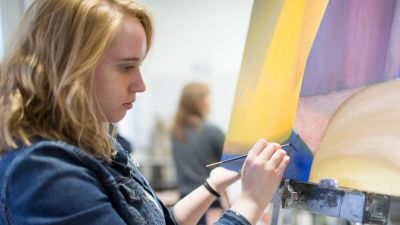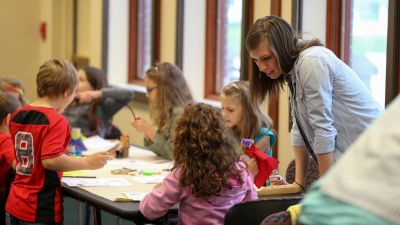
B.S.Ed. Art Education
A degree in art education from Concordia University, Nebraska gives you a broad range of skills with studio- and design-based courses that provide models for both learning and leading in a classroom. Coupled with course work in art history, you will gain exposure to a variety of media, technology and art methods, all of which prepare you to be an art educator in a classroom or any number of other settings. You’ll also receive a strong grounding in education and art theory, instructional methodologies and the art area concentration of your choice.
The art education program prepares you to enter the teaching profession through a balanced art curriculum of practical and theoretical content, or to work with other groups, teaching art techniques to your community!
Credit hours listed above are the minimum required for graduation. Specific program credit hours may vary.
Transform your students into critical observers of the world and teach them to express themselves through art!
Program Highlights
WHY STUDY ART EDUCATION AT CONCORDIA?
The art education program at Concordia University, Nebraska prepares students with basic skills in art methods, theories and educational practices so they are equipped to teach art at the elementary and/or secondary levels and to be leaders in the classroom, in the congregation and in the community.
Concordia’s Saturday Art School is a unique extra-curricular experience that places art education majors in the classroom as teachers working directly with children, to help give you the hands-on learning you need to teach art or art appreciation programs.
Learn more about art at Concordia.
Art Club
Art Club is a student-led group that provides an opportunity for students to come together in a community outside of the classroom setting to engage in conversation on different ideas happening in art.
MEET OUR EXPERT FACULTY
As experts in art education, our faculty and instructors bring years of experience to the classroom.
Meet our students
“I think that the best way to describe the art department at Concordia is simply amazing. Whether it's the professors or even the upperclassmen, there is always someone there to help answer your questions or give you their input on a project. I think that this supportive and family-like atmosphere is what many people, including me, come to like about the art department. ”
Abby Gerber
Columbus, Nebraska
Accreditation
Concordia University, Nebraska is accredited by the Higher Learning Commission, a regional accreditation agency recognized by the U.S. Department of Education.
Degree Goals
An art education program graduate from Concordia University, Nebraska will be able to:
- Demonstrate familiarity with art theory, criticism and art methods in a variety of visual media and art history.
- Demonstrate the ability to design a comprehensive, inclusive art curriculum that incorporates a variety of art education strategies.
- Use different teaching and assessment strategies to promote conceptual learning and artistic achievement.
- Demonstrate an understanding of the responsibilities and requirements of a professional art educator.
Art Minors
- Studio Art
- Art History
- Graphic Design
- Self-Directed
Career Outcomes
Art Teacher
- Inspire future artists and help increase motor skills and critical thinking in your students
- Teach art techniques such as painting, drawing, printmaking, photography and/or ceramics, as well as art theory and history
Museum Educator
- Ensure that collections in art museums or galleries function as learning resources for the community
- Develop educational programs to engage and inform your community
Community Art Coordinator
- Promote art to local groups or individuals
- Teach art techniques to engage and educate people in your community
- Manage and coordinate events and activities with local artists to encourage creativity
FAQs
How do I become an art teacher?
The first thing you need to be a successful art teacher is a love of art. You should have some basic skills in oil painting, watercolor, sculpture and other types of art mediums. You’ll also need at least a bachelor’s degree. At Concordia University, Nebraska, you can earn your bachelor of science in art education degree, specifically designed to help you become an art educator in K-12 schools.
Students in the art education program at Concordia complete two semesters of student teaching, first close to campus, learning while taking courses and using your art and education classes and the expertise of your professors to help you become an innovative and effective art teacher. In the second semester of student teaching, you will assume more teaching responsibility and complete your training nationally, so you gain the valuable experience you need to take into your future art classroom.
To teach art in a school, you’ll also need to obtain your teacher’s certification, the requirements for which vary from state to state. Concordia will help you through your certification process, making sure you’re fully equipped and prepared to teach after graduation.
What is the importance of art in child development?
Creative activities are vital in child development. As an art educator, you will be responsible for helping your students of any level of talent or age develop fine motor skills, visual learning techniques and decision-making processes. Art can also help children explore critical thinking and cultural awareness. According to Americans for the Arts, children who participate regularly in the arts are four times more likely to be recognized for academic achievement. As an art teacher, you will be a critical part of the development of your students’ minds.
Related Programs

Studio Art
A degree in studio art from Concordia University, Nebraska is a degree in critical thinking, visual and spatial reasoning and creative problem solving. Through a sequence of studio and design courses, you will be introduced to a wide range of materials and procedures from basic two- and three-dimensional media to multi-disciplinary experimentation. Through historical and theoretical content, you can engage with art’s critical discourse. Here, you can make connections across disciplines and learn how to use visual language to express your ideas, make social commentary, effect change and celebrate beauty. A studio art degree from Concordia Nebraska will help you not only achieve personal fulfillment through creative expression, but also give you the framework to be a professional within the art field.

Art Therapy
The art therapy program at Concordia, the only one of its kind in Nebraska, will prepare you to serve in the health field through your art. A degree in art therapy provides you with a quality foundation for you to use your creative process to help people of all ages improve their health and emotional well-being. With your art therapy degree, you can work in schools, nursing homes, prisons, hospitals, recreation facilities, mental health hospitals and nonprofit agencies.

Elementary Education
As an elementary educator, you are certified to teach children in kindergarten through sixth grade. You will typically spend the day with the same group of students, teaching them foundational skills in a wide variety of subjects. The liberal arts education you will receive at Concordia University, Nebraska, along with subject-specific methodology courses in the education department, will prepare you to be an outstanding elementary school teacher.

Middle Level Education
The middle level education program at Concordia Nebraska connects theory with practice to prepare graduates to teach grades 5 through 9 in both self-contained and departmentalized classrooms. As a middle level education major, you will choose from among math, science, social sciences and language arts and have the opportunity to add a second subject from those or Spanish, physical education and ELL/ESL, allowing your passion for teaching to connect with your subject-area passions, which you can share with your students.

Secondary Education
With a degree in secondary education from Concordia University, Nebraska, you will be equipped to teach grades 7-12, encouraging intellectual and emotional growth at a critical time in the lives of your students. You’ll engage in rich coursework, collaborate with faculty and gain invaluable experience first shadowing a professional teacher and then teaching in your own high school classroom.
1 Recent graduates attending graduate school or employed within six months of graduation.
2Average Class Size for Representative Subject Most Aligned with Major, Over Last 5 Years.